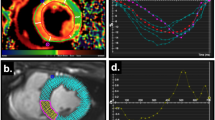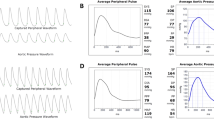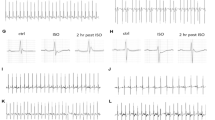Abstract
Physiologic indices that reflect intracellular Ca2+ cycling were chosen to evaluate contraction and relaxation properties of the univentricular heart. We hypothesized that these indices would be impaired in univentricular hearts. With advances in surgical palliation, an increasing number of children are surviving with univentricular hearts supporting the systemic circulation. Similar to the adult failing heart, single ventricles may also manifest impaired Ca2+ cycling, which may have important therapeutic implications. In our study, we did not actually measure Ca2+ uptake or transients in the cardiac myocyte. Rather, we used previously validated physiologic indices that are known to reflect Ca2+ cycling. Sixteen children were studied, eight with single ventricles (SV) and eight as matched control subjects. Systolic properties were studied using maximal derivative of ventricular pressure (dP/dtmax), force–frequency relationship, and mechanical restitution. Diastolic properties were assessed using time constant of relaxation (τ) and the relaxation–frequency relationship. The critical HR (HRcrit) was assessed from the force–frequency relationship and relaxation–frequency relationship. DP/dtmax and τ were calculated from micromanometric tracings at increasing HRs, generated by right atrial pacing. In SV patients, dP/dtmax was lower than in the control group at each matched HR, and the force–frequency relationship was shifted downward. Restitution of contractility was slower in patients with SV. Tau was similar in both groups at lower HRs but significantly prolonged in the SV group at faster HRs. In the SV, HRcrit was significantly shifted to the left. These findings indicate impaired systolic and diastolic properties of univentricular heart, especially at increased HRs. Because these physiologic indices reflect Ca2+ cycling, it is speculated that the phenomenon of Ca2+ cycling may be impaired in the myocytes of univentricular hearts.
Similar content being viewed by others
Log in or create a free account to read this content
Gain free access to this article, as well as selected content from this journal and more on nature.com
or
Abbreviations
- SR:
-
sarcoplasmic reticulum
- τ:
-
time constant of relaxation
- LV:
-
left ventricular
- RV:
-
right ventricular
- HR:
-
heart rate
- MR:
-
mechanical restitution
- ESI:
-
extrasystolic interval
- dP/dtmax:
-
maximal derivative of ventricular pressure
- HRcrit:
-
critical heart rate
REFERENCES
Driscoll DJ, Offord KP, Feldt RH, Schaff HV, Puga FJ, Danielson GK 1992 Five-to-fifteen year follow-up after Fontan operation. Circulation 85: 469–496
Graham TP, Franklin RCG, Wyse RKH, Gooch V, Deanfield JE 1986 Left ventricular wall stress and contractile function in childhood: normal values and comparison of Fontan repair versus palliation only in patients with tricuspid atresia. Circulation 74: I61–I69
Sluysmans T, Sanders SP, Vand der Velde M, Matitiau A, Parness IA, Spevak PJ, Mayer JE, Colan SD 1992 Natural history and patterns of recovery of contractile function in single left ventricle after Fontan operation. Circulation 86: 753–761
Fogel MA, Weinberg PM, Chin AJ, Fellows KE, Hoffman EA 1996 Late ventricular geometry and performance changes of functional single ventricle throughout staged Fontan reconstruction assessed by magnetic resonance imaging. J Am Coll Cardiol 28: 212–221
Parikh SR, Hurwitz RA, Caldwell RL, Girod DA 1991 Ventricular function in the single ventricle before and after Fontan surgery. Am J Cardiol 67: 1390–1395
Frommelt PC, Snider AR, Meliones JN, Vermilion RP 1991 Doppler assessment of pulmonary artery flow patterns and ventricular function after the Fontan operation. Am J Cardiol 68: 1211–1215
Akagi T, Benson LN, Gilday DL, Ash J, Green M, Williams WG, Freedom RM 1993 Influence of ventricular morphology on diastolic filling performance in double-inlet ventricle after the Fontan procedure. J Am Coll Cardiol 22: 1948–1952
Banerjee A, Mendelsohn AM, Knilans TK, Meyer RA, Schwartz DC 1998 Effect of myocardial hypertrophy on systolic and diastolic function in children: insights from the force-frequency and relaxation-frequency relationships. J Am Coll Cardiol 32: 1088–1095
Perreault CL, Shannon RP, Komamura K, Vatner SF, Morgan JP 1992 Abnormalities in intracellular calcium regulation and contractile function in myocardium from dogs with pacing-induced heart failure. J Clin Invest 89: 932–938
Gwathmey JK, Copelas L, MacKinnon R, Schoen FJ, Feldman MD, Grossman W, Morgan JP 1987 Abnormal intracellular calcium handling in myocardium from patients with end-stage heart failure. Circ Res 61: 70–76
Eising GP, Hammond K, Helmer GA, Gilpin E, Ross J 1994 Force-frequency relations during heart failure in pigs. Am J Physiol 267: H2516–H2522
Wier WG, Yue DT 1986 Intracellular calcium transients underlying the short-term force-interval relationship in ferret ventricular myocardium. J Physiol 376: 507–530
Brutsaert DL, Housmans PR, Goethals MA 1980 Dual control of relaxation: its role in the ventricular function in the mammalian heart. Circ Res 47: 637–652
Khoury SF, Hoit BD, Dave V, Shao Y, Babel M, Periasamy M, Walsh RA 1996 Effects of thyroid hormone on left ventricular pressure and regulation of contractility and calcium cycling proteins in the baboon: implications for the force frequency and relaxation frequency relationships. Circ Res 79: 727–735
Burkhoff D, Yue DT, Franz MR, Hunter WC, Sagawa K 1984 Mechanical restitution of isolated perfused canine left ventricles. Am J Physiol 246: H8–H16
Vatner DE, Sato N, Kiuchi K, Shannon RP, Vatner SF 1994 Decrease in myocardial ryanodine receptors and altered excitation-contraction coupling early in the development of heart failure. Circulation 90: 1423–1430
Freeman GL, Colston JT 1990 Evaluation of left ventricular mechanical restitution in closed-chest dogs based on single-beat elastance. Circ Res 67: 1437–1445
Weiss JL, Frederikson JW, Weisfeldt ML 1976 Hemodynamic determinants of the time-course of fall in canine left ventricular pressure. J Clin Invest 58: 751–760
Sano T, Ogawa M, Taniguchi K, Matsuda H, Nakajima T, Arisawa J, Shimazaki Y, Nakano S, Kawashima Y 1989 Assessment of ventricular contractile state and function in patients with univentricular heart. Circulation 79: 1247–1256
Kambayashi M, Miura T, Oh BH, Rockman HA, Murata K, Ross JJ 1992 Enhancement of the force-frequency effect on myocardial contractility by adrenergic stimulation in conscious dogs. Circulation 86: 572–580
Kadambi VJ, Ball N, Kranias EG, Walsh RA, Hoit BD 1999 Modulation of force-frequency relation by phospholamban in genetically engineered mice. Am J Physiol 276: H2245–H2250
Ross JJ, Miura T, Kambayashi Eising GP, Ryu KH 1995 Adrenergic control of the force-frequency relation. Circulation 92: 2327–2332
Bers DM 1991 Excitation-Contraction Coupling and Cardiac Contractile Force. Kluwer Academic Publishers, Norwell, MA, pp 155–158, 167–170.
Somura F, Izawa H, Iwase M, Takeichi Y, Ishiki R, Nishizawa T, Noda A, Nagata K, Yamada Y, Yokota M 2001 Reduced myocardial sarcoplasmic reticulum Ca2+ ATPase mRNA expression and biphasic force-frequency relations in patients with hypertrophic cardiomyopathy. Circulation 104: 658–663
Liu CP, Ting CT, Lawrence W, Maughan L, Chang MS, Kass DA 1993 Diminished contractile response to increased heart rate in intact human left ventricular hypertrophy: systolic versus diastolic determinants. Circulation 88: 1893–1906
Anderson PA, Rankin JS, Arentzen CE, Anderson RW 1976 Evaluation of force-frequency relationship as a descriptor of the inotropic state of the canine left ventricular myocardium. Circ Res 39: 832–839
Frederiksen JW, Weiss JL, Weisfeldt ML 1978 Time constant of isovolumic pressure fall: determinants in the working left ventricle. Am J Physiol 235: H701–H706
Katz AM 1988 Sarcoplasmic reticular control of cardiac contraction and relaxation. In: Grossman W, Lorell BH (eds) Diastolic Relaxation of the Heart. Martinus Nijhoff Publishing, Boston, pp 11–15.
Aroesty JM, McKay RG, Heller GV, Royal HD, Als AV, Grossman W 1985 Simultaneous assessment of left ventricular systolic and diastolic dysfunction during pacing-induced ischemia. Circulation 71: 889–900
Anderson PA, Manring A, Serwer GA, Benson DW, Edwards SB, Armstrong BE, Sterba RJ, Floyd RD 1979 The force-interval relationship of the left ventricle. Circulation 60: 334–348
Lemes V, Ritter SB, Messina J, Gold JP 1995 Enhancement of ventricular mechanics following bidirectional superior cavopulmonary anastomosis in patients with single ventricle. J Card Surg 10: 119–124
Donofrio MT, Jacobs ML, Spray TL, Rychik J 1998 Acute changes in preload, afterload, and systolic function after superior cavopulmonary connection. Ann Thorac Surg 65: 503–508
Acknowledgements
We thank Dr. David C. Schwartz, former chief of cardiology, Children's Hospital Medical Center, Cincinnati, for support and encouragement during this study. We also thank Drs. Jonathan Rhodes and Hitendra T. Patel from Tufts University School of Medicine, Boston, for carefully reviewing the manuscript.
Author information
Authors and Affiliations
Corresponding author
Additional information
Supported by postdoctoral fellowship grant from the American Heart Association, Ohio-West Virginia Affiliate.
Rights and permissions
About this article
Cite this article
Erenberg, F., Banerjee, A. Systolic and Diastolic Properties of Univentricular Hearts in Children: Insights from Physiologic Indices That Reflect Calcium Cycling. Pediatr Res 54, 885–891 (2003). https://doi.org/10.1203/01.PDR.0000090930.17613.D8
Received:
Accepted:
Issue date:
DOI: https://doi.org/10.1203/01.PDR.0000090930.17613.D8



